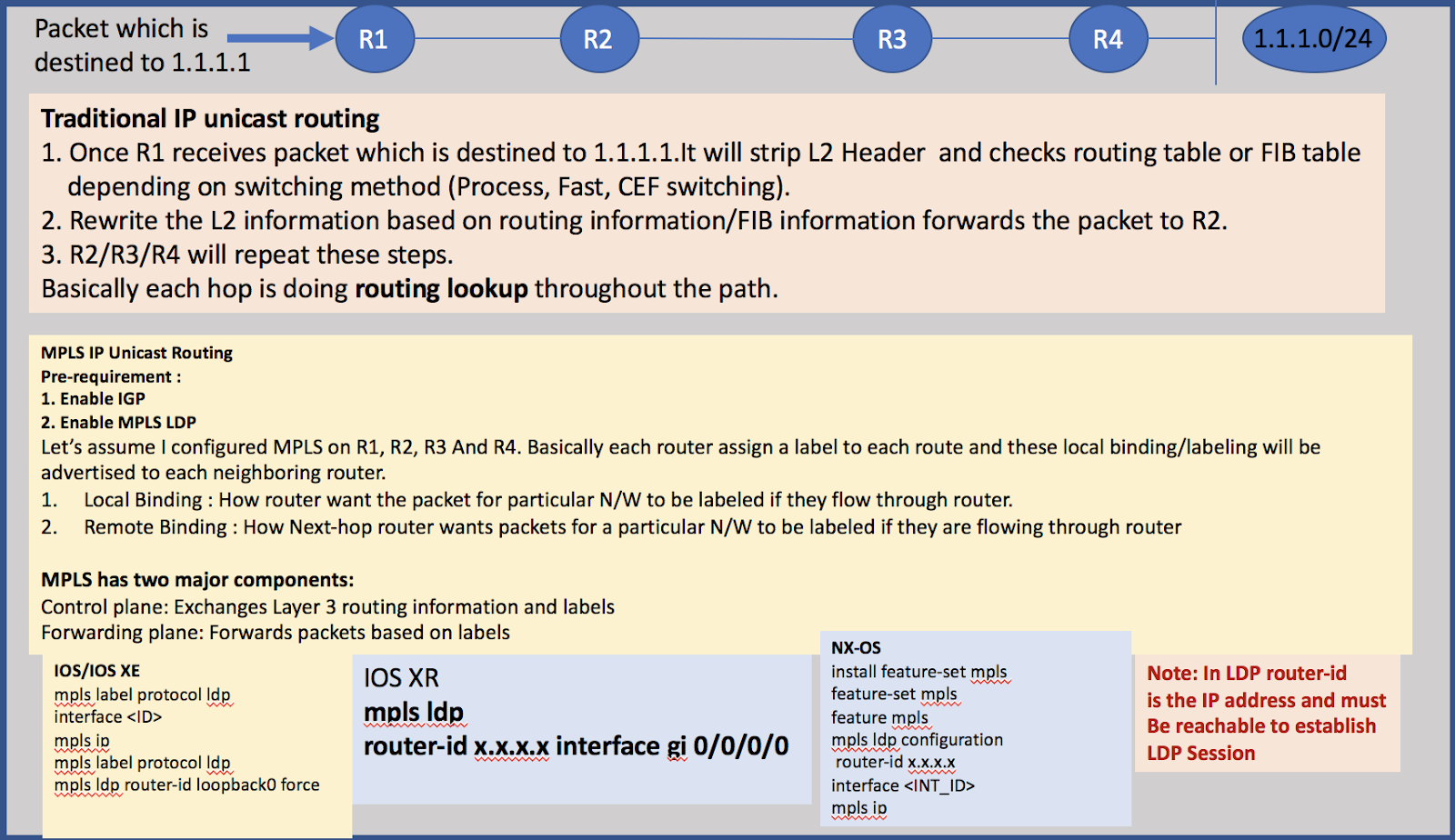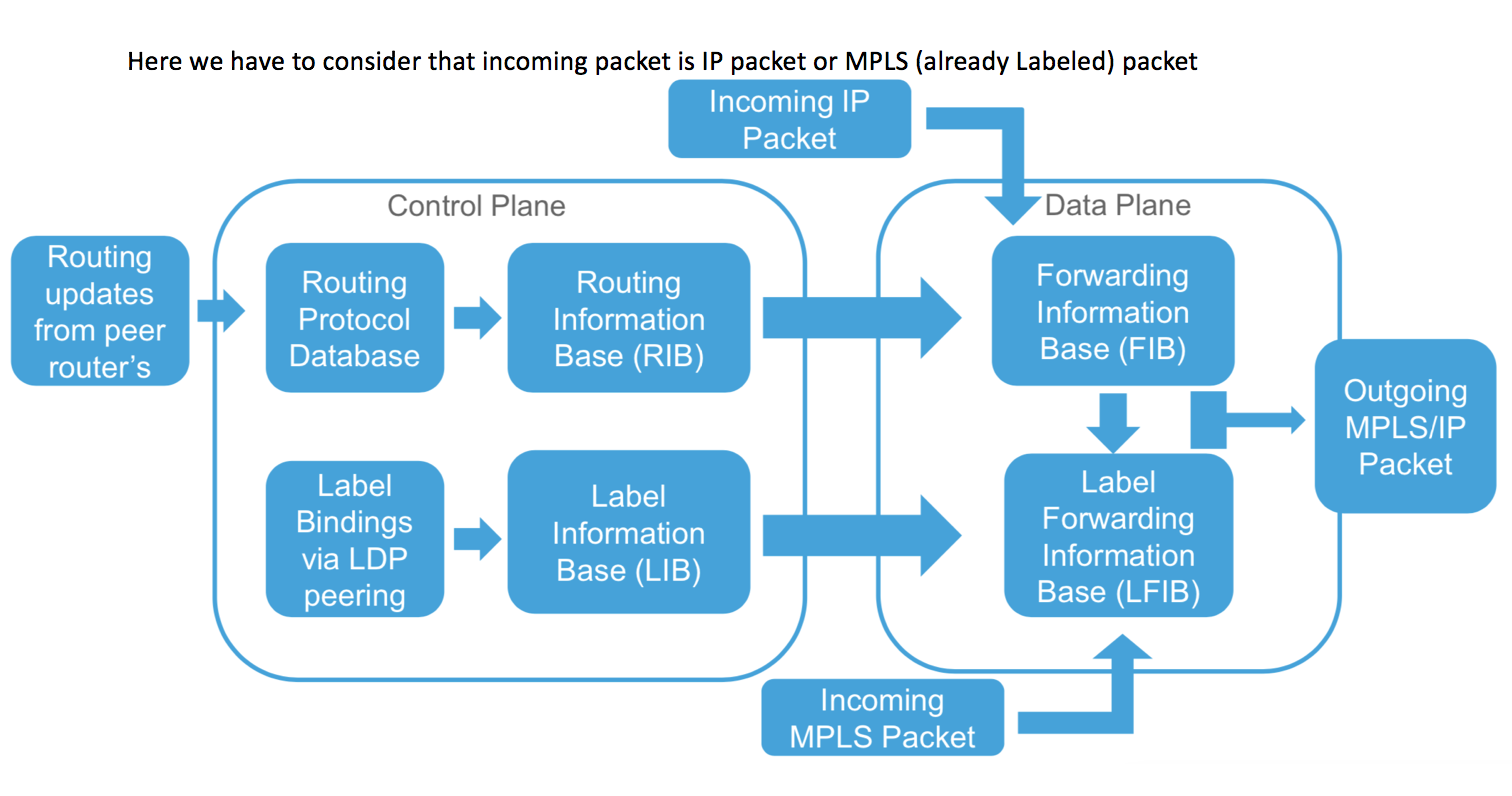Categories
What is MPLS?
MPLS stands for Multi-Protocol Label switching”.
Multi-Protocol: Multi-Protocol means can transport different Payloads and Payload can be either Layer 2 (Ethernet/FR/PPP etc) or Layer 3 (IPv4, IPv6).
Label Switching: Switches traffic between interfaces based on locally significant label values.
How Label switching is different from traditional routing?
As we know that in a traditional network, each router performs an IP lookup (“routing”), determines a next-hop based on its routing table, and forwards the packet to next-hop and this process repeated on every router throughout the path until the final destination is reached.
In Label switching, first router (PE) does a routing lookup just like before for IP Packet but instead of finding a next-hop it finds remote PE (Final router) and will add MPLS label to IP Packet. Intermediate routers use a label to route the traffic. Remote PE (where destination exists) will remove the label and will send a regular packet via normal IP routing.
Let’s take an example as below:
MPLS Terminology:
1. Provider Router (PE): PE router also referred as LER (Label Edge Router). Router which connects to Customer Edge device. Basically PE is responsible to accept unlabelled packets (IP/IPv6 packets) and imposes(Push) one or more MPLS labels on traffic when traffic is coming from Customer as well as responsible to removes(POP) labels at the edge of the network and sends unlabelled packets when traffic is going out to Customer.
2. CE(Customer Edge): Router which is connected to provider network and belongs to particular customer. Typically it’s not MPLS aware.
3. P-Router (P): P-Router is known as a Label switching router(LSR). Any device that switches packets based on the MPLS label.
4. LSP (Label switched Path): The path that a labeled packet traverses through a network, from label imposition to disposition. An LSP is the pre-determined path established between two routers (LER) to route traffic in an MPLS network. LSP is established over a sequence of LSRs based on the criteria in the FEC. It is only after an LSP has been established that MPLS forwarding can occur. LSPs are unidirectional which means that return traffic is sent over a different LSP.
5. FEC(Forwarding Equivalence Class): Any set of properties that map incoming packets to the same outgoing label. Generally, an FEC is equivalent to a route (all packets destined for anything inside 11.0.0.0/8 match the same FEC), but the definition of FEC can change when packets are routed using criteria other than just the destination IP address (for example, DSCP bits in the packet header).
6. VRF (Virtual Routing and forwarding):
7. RD: RD is only used to make routes unique VPNv4 prefix. As we know that we separate customer using VRF and every CE routes from all VRF’s are placed in a single VPNv4 BGP table. As we are using different VRF so customer can have overlapping subnet but the question is how are routes from one VRF distinguished from another VRF in VPNv4 Table?
By prepending the RD to the route to create a unique prefix for VPNv4 table.
Note: RD must always be defined even if we are not using MPLS. RD must be unique to the VRF on Local PE.
8. Route Target (RT): RT is a BGP extended community which is used to decide where (to particular customer vrf) to install BGP VPNv4 route.
## Route-target import” defines which routes to bring into the VRF.
## Route-target export” adds the community to the outbound update.
## Multiple imports and exports allowed.
Something About VPN:
As we know that VPN is a private network that uses a public network (usually the Internet) to connect remote sites or users together. Instead of using a dedicated, real-world connection, such as leased line, a VPN uses “virtual” connections routed through the Internet from the company’s private network to the remote site or employee.
!
MPLS VPN allows for the creation of virtual private networks using MPLS. There are three types of MPLS VPNs that are in use:
- Point-to-Point (Pseudowire)
- Layer 2 MPLS VPN or VPLS
- Layer 3 MPLS VPN
Here we are going to discuss MPLS layer 3 VPN:
- Layer 3: The service provider will participate in routing with the customer. Customer can any routing protocol (IGP or BGP ) with the service provider and learned routes can be shared with other sites of the customer.
- VPN: Routing information from one customer is completely separated from other customers and tunnelled over the service provider MPLS network to different site of Customer.
MPLS L3VPN have to address three main issue:
How to keep customer routes separate and unique on PE (Provider Edge Router).
## This is achieved using VRF for each customer and by defining RD.
How to allow customer to exchange routes.
## Using MP-BGP VPNv4
How to get customer traffic to far side of PE?
## Using LSP
To understand these terminology please go through below topology:
Above we have two customers connected to MPLS core. Customer A and B each have two sites and you can see that they are using the same IP ranges.
- Setup MPLS cloud here I am using OSPF and LDP.
Table needs to be added.
- Configure IBGP peering between PE.
- Configure VRF for each Customer.
- Configure IGP or BGP or Static route to learn customer routes which is going to be placed in customer VRF.
- Take route learned from Customer VRF and needs to be placed in BGP (VPNv4) using redistribution.
- IBGP peer will exchange these routes with each other.

